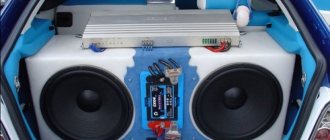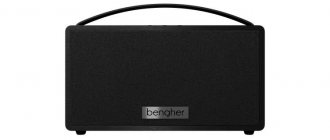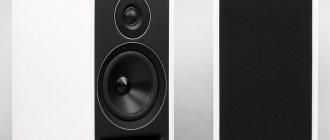To properly design an indoor audio system (either a separate one or part of an overall multiroom system), it is important to understand how it will be used. Here are possible scenarios:
- Background music only, no video (no TV or projector in the room)
- Boost sound from a TV or projector for watching movies or playing games
- Sound combined with video, both in the background
Depending on the scenario, there may be different speaker placements and different equipment choices.
Now I’ll explain what the difference is between these options (especially the second and third) and where I’m going with all this.
Background music
Background music plays without reference to the video. This could be a microsystem (something like what used to be called a “music center”), a Wi-Fi speaker (which contains both an amplifier and a sound source) or mounted/built-in acoustics with a separate amplifier.
Micro systems and Wi-Fi speakers often have Bluetooth support for transmitting audio to an audio system from a device located in the same room. This applies, for example, to Denon Heos and Yamaha speakers.
Yamaha WX-030
Almost all modern speaker systems have support for Apple Airplay, which makes it possible to transfer sound from Apple devices to the audio system. In particular, Soos does not have Bluetooth (it does, but not for audio transmission), but it does have Airplay.
When arranging speakers for a background music audio system, we simply place the speakers as symmetrically as possible so that the sound is uniform and the distance from the center of the room to all speakers is approximately the same.
Two speakers in the room is good. Sufficient for a room of up to 20-25 square meters, especially if it is rectangular in shape. But 4 speakers will give better sound. For rooms up to 40-50 square meters, it is better to take 4 speakers. You can connect them to a stereo amplifier with two cables (2 speakers on each cable); if you use a multi-channel amplifier (Sonance 12-50, for example), then we pull a separate speaker cable from each speaker).
There are built-in speakers with two speakers, stereo at once. Sonance will have the letters SST/SUR in the names of these speakers.
Sonance VP46R SST/SUR
You can place one stereo speaker in a very small room, up to 6-7 meters. In the bathroom or shower. The sound will be much nicer than from one regular speaker. For larger rooms, it is better to use two or more speakers for more distributed sound.
You need to run two speaker cables to the stereo speakers.
The sound source in modern multiroom systems can be a music service (Apple Music, Google Music, Spotify and others; Russian services are rarely supported), Internet radio, music from a file server, music from a separate analog sound source (vinyl, for example).
How to place speakers in a room?
There is little that can compare with the truly high-quality and deep sound of a good audio system. But the secret of sound lies not only in the volume and parameters of the speakers, but also in exactly how they are located. Modern audio systems are not at all as difficult to install as it seems at first glance. It is enough to understand the nature and specifics of audio waves. To ensure that you do not have problems with your speakers, we decided to take advice from professionals in the field of audio systems and select recommendations that will help you achieve ideal acoustics in the room.
So, let's start with the fact that the placement of speakers in a room largely depends on the speakers themselves. Please note that they come in different shapes, characteristics and sizes. Today you can buy a stereo device with or without a receiver, you can choose a configuration with a subwoofer, or choose one speaker that, despite its size, will be loud and with powerful bass. That's why we'll look at all the common types of speakers and find out exactly how best to place them. All you have to do is follow the instructions and enjoy high-quality sound.
- Consider everything from the very beginning
Of course, before you purchased an audio system, you took care of where exactly you were going to place it. Ideally, you need to take into account both the size of the room and the height of the ceilings. Most likely, no one furnishes the living room with the most sophisticated 7.1.2 configuration in mind, but this is not a problem, and everything can be fixed.
To begin with, we note that properly installed speakers allow audio waves to move freely without being reflected from surfaces. The more surfaces, the greater the reflection and, as a result, the distortion of sound. Therefore, minimalism and a large number of bare walls or panoramic windows are not at all compatible with rich sound. However, this does not mean that it is necessary to arrange a rearrangement, because everything can be smoothed out with the help of a balanced arrangement and some programs designed for sound calibration.
But if you are just starting a renovation and are immediately considering the placement of speakers, then it’s time to take their placement into account in the project.
- The right speaker for the room
It's not only important to have the right room for your speakers, but also to choose the right speaker for the room. If the room is small, you definitely shouldn’t take a large speaker. It all comes down to personal preference, but it's worth noting that modern manufacturers are practically cheating physics with DSP or digital signal processing. In other words, under ideal conditions you have two speakers, left and right, respectively, they are located symmetrically on the left and right. DSP allows you to process sound so that even one speaker can create a similar effect. For a small room this is very convenient because the sound does not travel far and is reflected faster.
If you use one speaker, you need to place it straight, pointing at the place where you plan to listen to it. It is with this calculation that sound is processed and output inside it. In this case, it is most effective to use a small device so that you can rearrange it depending on where you are.
The same DSP technology is used in multi-speaker configurations, although it may not be fundamentally important in such cases, but it helps balance and calibrate the sound when necessary. Under ideal conditions this will not have to be done, but it is always necessary to make allowances for the specifics of the room.
- Speaker placement in the corner
The very common choice of placing one or more speakers in a corner is, in fact, a controversial decision. Most professionals do not recommend doing this, but there are exceptions. If you need to increase the bass in an audio system, then this arrangement will be very justified. If we talk about the reasons, when the speaker is turned from a corner, the sound is reflected, among other things, from the walls surrounding it. Since the walls are nearby, at such a short distance, the sound waves move simultaneously and in the same direction. If you place a large speaker in a corner, the bass gets louder, as does the overall sound, but overall, the volume of the sound is lost. Well, if you put a small speaker in a corner, you simply lose its sound from the general flow, and it, in fact, does not serve any function.
30 cm is a reasonable distance by which the speaker can be moved away from the wall so that nothing interferes with the sound.
- Correct speaker placement
Let's imagine that there is a sofa in the center; it is the place where the sound should be directed. Thus, the center channel should be directly opposite the sofa and be turned towards it, the left and right should be at the same distance and also turned towards the sofa, the rear surround speakers are located behind or on the sides and, most often, they are placed a little higher.
Please note that any two identical speakers must be located at the same distance. This is true even for 2.1 configurations.
- Additional setup and calibration
Most systems today allow sound calibration so that the necessary channels are output while listening to music, dialogue is louder while watching TV, etc. All this is done to ensure that the sounds are processed and played back based on what you are doing. Most often, this is done automatically so that the user does not have to tinker with equalizers, and it turns out that we completely trust those functions that we cannot control. Most often, the settings are calibrated by professionals, but if you choose manual settings, it won’t hurt to do a little research first and check the sound from exactly where you plan to watch or listen. In this regard, you should also rely on your own perception of sound, since standards may differ from tastes. Professionals recommend that you always test settings on films or tracks that you know well and for which you have long had an idea of the correct sound.
- Subwoofer
Despite the prevalence of these speakers, they are not at all a necessary element. Essentially, their task is to add bass, which other speakers sometimes cannot cope with. In practice, it is responsible for most of the low frequencies. For specific genres of music and film, this is always useful. Quality speakers can handle the bass and low frequencies quite well so that you hardly notice the difference, which is why a subwoofer is an addition for amateurs.
If you are sure that you need additional bass, then be sure to get a subwoofer so that the sound is more spacious and the frequencies stand out. Just in case, take care of sound insulation so as not to bother your neighbors, since loud bass tends to cause quite physical vibrations.
The placement of the subwoofer is also very important: the closer the subwoofer is located to the wall, the deeper the bass will be. In this case, the same effect will work as with other speakers. This will definitely benefit inexpensive and not very loud subwoofers, increasing their power. But a high-quality and loud device will not benefit much from this; it can be safely placed 30 cm from the wall, like other speakers. It is usually placed in front of the sofa or the center of the room, and on the floor.
- Additional functions
Of course, you can purchase a complete, already assembled audio system, or assemble it yourself piece by piece. In this case, it is not always necessary to even stick to one brand. Also, look for apps and advanced features. Many audio systems are compatible with devices like Chromecast or Echo Dot, which will expand the capabilities and allow you to control the process with greater comfort. The same goes for home smart speakers, with their help you can control viewing, volume and much more. Make sure your audio system has the ability to connect additional devices, and simply choose and add what you find convenient. And if you are buying a system for a long time, then it is best not to ignore such functions as bluetooth, Wi-Fi and additional synchronization capabilities, because no one knows what will appear in a year or even two. It's best to be prepared for any additions.
- One room or several?
If you don't want to be limited to one room, and want to provide your entire apartment or entire house with a common sound system, then we have great news. This is possible and very easy with a Wi-Fi connection throughout your home. Of course, for this you will need a fairly fast connection, otherwise the load on Wi-Fi may affect other processes. However, many speakers allow you to not only assemble the necessary configuration, but also add a large number of devices, so you can place them in different rooms and control them even from your smartphone. Modern speakers will allow you to do quite a lot, including the ability to play different tracks in different rooms.
The secret of good acoustics is to ensure that the right sound reaches the ear at the right moment. To do this, when placing it, it is important to take into account the distance, room size and volume.
Urbanears Stammen Vynil is a speaker system designed for listening to a vinyl record player. The speaker can be used as one solid device, or combined and used as a whole system. The settings allow you to create playlists and turn them on at any time, you can listen to the radio, music and watch movies while enjoying the high-quality sound of this speaker. Thanks to the Wi-Fi connection, you will be able to organize a multiroom system without using wires. Synchronize playback, or create a separate atmosphere in each room. There are physical buttons on the body of the device; by turning or pressing, you can change the track or increase the volume. The sound format of Urbanears Stammen is 2.1, the reproduced frequency range is 50-20000Hz, and there is a headphone jack on the body. The speaker supports Bluetooth and AirPlay, providing you with a rich playback experience.
Cinema audio system
Here is the main idea that prompted me to write this article:
When watching television, the main sound should come from the TV!
When you connect any audio system to the TV, the TV's built-in speakers are disabled.
There is no need to try to supplement the built-in speakers of the TV with rear acoustics, since the rear speakers should go to the rear channel of the film you are watching, that is, those audio tracks that the filmmakers have prescribed as sounding from behind.
There is no need to try to feed sound from the TV to the ceiling speakers of the background music system (as I described in the previous paragraph), even if the ceiling speakers and amplifier are very powerful and high quality. When we look at a TV (or a projector screen), the most powerful sound should come from the TV. This is either a soundbar or speakers to the right and left of the TV on the floor or on the wall.
Sonance has a series of in-ceiling speakers for its In-Ceiling Reference home theater system, but they must be positioned above the TV and designed to sound like it's coming from the TV.
Watching TV and hearing sound coming not from it, but from the other side (from the ceiling) is very inconvenient. Completely inconvenient. Making the TV's built-in speakers plus the ceiling speakers work is even worse, because the TV system is designed to be self-sufficient, the sound will be unbalanced and possibly out of sync.
And for movies, games, concerts, the main sound should come from the TV or screen. The options are as follows:
- Soundbar under TV or screen, optional additional subwoofer and rear speakers.
- Two floor-standing or wall-mounted or wall-mounted speakers to the right and left of the TV or screen. This is system 2.0.
- In addition to two speakers there is a subwoofer. This is 2.1.
- In addition to two speakers and a subwoofer, there is a center speaker and rear speakers. It's 5.1 or higher.
If in a large room (kitchen-living room) you are planning a “cinema zone” with a 5.1 audio system that occupies some part of the room, then it is better to hang separate speakers above the dining table specifically for background music, since the music playing in the cinema zone is aimed at a person , sitting on the couch in it, will not sound nearly as good outside the cinema area. And if the cinema occupies most of the room, it is quite possible to listen to music separately from the video from the audio system.
Here is an example of the placement of 7.1 audio system speakers in the kitchen-living room:
In the project, the “lower” part of the room is the living room, there is a sofa between the side speakers (closer to the screen than the projector), the sound from all speakers is aimed at ensuring that listeners on the sofa get the best sound. And in the “upper” part of the room there is a kitchen area. With this layout, of course, the person “at the stove” will be able to hear the sound from the audio system perfectly. But if the housewife just likes to listen to music or some podcasts while cooking, then it is better to provide two ceiling speakers with a separate amplifier above the kitchen.
Correct placement of the subwoofer
The placement of acoustics in the room ends with determining the optimal location for placing the subwoofer. This is explained by the significant influence of various factors on the sound of a low-frequency loudspeaker - the location of furniture, the specific material of the reflective planes, the location of the subwoofer and others.
What recommendations should you follow when choosing the correct location for the subwoofer? The key ones are listed below:
- It is optimal to choose rectangular-shaped rooms for installing a home theater. In a square room, the subwoofer sounds as poor as possible;
- The worst place to install a low-frequency speaker is in the center of the room. As the sub gets closer to the wall, it increases the bass level when the audio system is operating;
- Placing the sub in the corner will allow you to get good low-frequency sound, but the resonance effect will also be most pronounced;
- It is not advisable to use a subwoofer in a room with concrete walls without additional sound insulation or facing materials. In this case, the “bubbling” effect will be guaranteed. To eliminate it, it is worth using plasterboard sheets, chipboard or other pre-damped enclosing structures.
As you have probably already seen, finding the optimal arrangement of acoustics in a room is a very complex and painstaking process. But its result can exceed all the wildest expectations of the owner. That is why it is worth using the services of professional installers from Hi-Fi Design and solving this problem in the best possible way.
We also have a review on the website that you can read: Installing front speakers
Sound combined with video
This means that we have a TV or screen as a signal source, but we don’t have to look at them. This is not watching a movie or playing a game, but something like a TV show or clips on YouTube. That is, the person does not necessarily look at the screen, he can be in any part of the room or even in another room, but the sound source goes along with the video.
That is, our sound source can be a TV (with a SmartTV system or a built-in receiver), a set-top box like AppleTV, or even a computer as a media player. We connect them to the input of an amplifier or a device such as Sonos Port or Sonos Amp, and to them are speakers evenly distributed throughout the room, as for ordinary background music.
In this case, sound control will occur from the TV or set-top box application, this will be the choice of video. Volume control is there too. But the volume balance between the speakers and the choice of zones in which the speakers play is in the audio system application, but this does not pose a big inconvenience.
Correct placement of acoustics: center channel
It would seem that by definition there can be no secrets regarding the location of the central channel. You place it directly in front of the listener where the furniture allows - voila! The distance doesn't really matter.
But in fact, there are several nuances that should be taken into account by every audiophile who decides to install acoustic components on their own.
It is necessary to understand that the center channel speaker is designed to tie the sound of the front speakers together. In addition, it is responsible for clearly reproducing dialogues. That is why finding the source of this audio signal and the source of the image must be as close as possible - otherwise, the occurrence of psychological dissonance when watching films is guaranteed. But is this always possible?
First of all, let's determine the distance to the front wall. Since other speakers are responsible for low frequencies, you will not feel any special effects when the central speaker is displaced relative to the front wall. If it does have a full range frequency response, it is worth installing it at the same distance as the other front speakers. As a rule, this is not difficult.
But the choice of installation height of the system is somewhat more important. By installing this speaker too high or too low, you will personally reduce the sound quality due to sound reflections from the ceiling and floor, respectively. In this case, it is necessary to increase the distance between the sound source and the reflection surface. If this is not possible, you will have to spend money on additional acoustic treatment of these planes.
Bedroom audio system
Let's take a special case: making good sound in the bedroom where the TV hangs. The bedroom area usually does not exceed 20 square meters, guests are not invited there, and computer games are not played.
First, you should think about whether you need to improve the sound from your TV; a built-in system may be enough. Especially if we consider high-price TVs, along with an excellent screen they also have good sound.
If the built-in sound is still not enough, then you can add a soundbar. There is no need to take the option for a cinema with Dolby Atmos; for a small room, a model like Sonos Beam (if the TV is hanging on the wall) or Sonos Playbase (if the TV is on a cabinet) is enough.
Sonos Beam
You can add rear speakers (two Sonos Ones) near the ceiling or a subwoofer to the soundbar. If this is Sonos, then you only need to provide 230 volt power outlets for the rear speakers and a socket for the subwoofer. For the soundbar itself, an electrical outlet and preferably an Internet outlet, as for the TV. In this case, it will be possible to use this audio system to amplify the sound from the TV and separately from the TV. The TV and soundbar are connected via an HDMI cable, through which the TV transmits sound and volume control commands to the system. On a TV, the HDMI cable is plugged into the connector next to which it should say ARC.
If not Sonos, then it’s more complicated: you’ll need to install a 5.1 receiver, HDMI from it to the TV, speaker cables to the soundbar, rear speakers and a subwoofer.
My opinion is that for a bedroom one soundbar will be enough, unless you are a fan of watching movies in bed. Since no special cables are required for one soundbar, you can purchase it after installing the TV, making sure that the built-in audio system is not enough.
Another option is if the audio system is needed not for watching movies, but for background music. To fall asleep and wake up with her. In the simplest case, this is a Sonos soundbar, which will work both with the TV and separately from it.
In a more advanced case, when you want to get more from the audio system: we install speakers in the ceiling. We place them so that they are symmetrical to the “ideal listener” and equidistant from him. Don't forget about acoustic boxes. The speakers are of a normal level, not lower than Sonance VP62R. There is no need for a subwoofer for background music; it plays little role when listening to music.
By the way, passive speakers connected to a Sonos cannot be used as rear speakers in conjunction with a Sonos soundbar. Only Sonos One supports this feature. You can combine the soundbar and Amp into one audio zone in the Sonos app, but then the same sound will come from the rear speakers as from the soundbar, and the rear channels must come from the rear channels for normal viewing.
22, total, today
Related posts:
- Audio multiroom on Sonos: selection of equipment In the spring of 2022, this article from 2022 is almost completely ...
- Review of Sonos equipment: Move, One SL, Port Only recently I wrote that the American company Sonos...
- Sockets and cables for home cinema The center of the cinema can be a TV, or maybe a projector with…
- Sonos Amp - a new multiroom system, review New from Sonos I almost missed the appearance of a new product on the market...
- Three new products from Sonos: ARC, FIVE, SUB Sonos has new products again. The last time new products appeared was…
- Installing speakers built into the ceiling Most often, multiroom audio systems are made using speakers built into the ceiling,…
- Multiroom audio system - what is it and why I consider multiroom audio systems one of the most underrated systems for...
Technical requirements for rear audio systems
Rear audio systems are not responsible for sound quality, but create a certain spatial effect. Therefore, their frequency range and sensitivity may be less than that of front-facing systems. However, the number of rear speakers should be such that the main speaker system has no unused channels. For example, if the front speaker uses the Dolby Digital codec, which has 5.1 channels, you can use one Polk Audio FXi A4 rear speaker from two speakers. And if the number of channels is 7.1 – Dolby Digital Plus codec, then the number of speakers increases to four.
Rear bipolar speakers
The design of the sound emitters themselves is also important. They come in three types:
- Monopolar - when all the speakers are on the same panel and the axis of sound propagation is the same.
- Bipolar - speakers on two different planes.
- Dipoles are structurally similar to the second ones, but the speakers work in antiphase.
Monopolar speakers provide maximum playback quality; the sound is the clearest and most precise. Therefore, they are not suitable for rear audio systems. Bipolar ones create a spatial effect, and dipoles create diffusion of the sound field, close to natural noise. These are the speakers that are best suited for rear speakers. Audio systems that operate in antiphase mode have the letters FX in their model index. Monitor Audio (UK) produces high-quality hi-fi speaker systems, the speakers of which can be switched from bipolar to dipole mode and varied sound effects.










